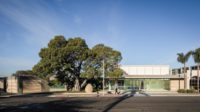Globe-trotting and media savvy, up in the Cloud and down-to-earth, Ramiro Losada and Alberto García represent a new breed of Spanish architect. While previous generations often sought the limelight by editing a magazine, as did Rafael Moneo, who cofounded Arquitecturas Bis in the 1970s, Losada, 35, and García, 33, launched Studio Banana TV, a multimedia platform that produces interviews and documentaries about design, art, and culture on the Web. They opened their first office in Madrid in 2008, but work was scarce due to Spain’s economic crisis. Losada decamped for southern California, where he teaches at the New School of Architecture & Design in San Diego, and García returned to the rural province of Cáceres, in western Spain, where they both grew up and were childhood friends. To maintain this bicontinental partnership, the two communicate daily via WhatsApp, in the car or on the jobsite, as if they were both still back in Madrid.
Web-based media have influenced the concepts and values on which the men build their designs. In their largest project to date, La Gota Cultural Center and Tobacco Museum in their hometown of Navalmoral, the irregularly stacked, glazed floors are screened by a mesh of ceramic tiles mounted on wires. With its lack of depth and visible structural support, this fabric-like curtain reads in photographs almost as a computer rendering. According to the architects, it creates “a dematerialized elevation of refined geometries.”
The conceptual element of their designs tends to be visual associations. Thus they compare the overlapping floors of La Gota Center to the branching pattern of leaves of a tobacco plant, in that each of them are both “alike and different.” For the Espacio Gourmet, a food kiosk in Madrid’s main business district, they found inspiration, without a trace of critical irony, in the modest social housing from the early 20th century that survives nearby.
Both partners trained as project managers before going on to study architecture, and this background gives them a solid hold on construction detailing. “In rural Cáceres, you can’t always work with every construction system,” Losada points out. “But we understand this not as a problem, but an advantage.” Meanwhile, in San Diego, he has been learning new management techniques, which he brings back to Spain.
Though they both worked at different times for Madrid architects Óscar Rueda and Maria José Pizarro, and profess admiration for Luis Mansilla and Emilio Tuñón, they don’t consider themselves disciples of anyone in particular, as was usually the case when Spanish architecture was more locally bound. “This probably has a lot to do with the internationality of the places where we’ve studied and worked,” Losada observes. For Losada and García, like others of their generation, one of the challenges of contemporary practice is how to move in this virtual, dispersed, and quickly changing world without losing touch with solid ground.
Losada García Architects
FOUNDED: 2008
DESIGN STAFF: 4
PRINCIPALS: Ramiro Losada Amor, Alberto García Jiménez
EDUCATION: Losada Amor: UE-Madrid, M.Arch., 2006; Universidad de Cáceres, M.Eng., 2001. García Jiménez: UE-Madrid, M.Arch., 2008; Universidad de Cáceres, M.Eng., 2004
WORK HISTORY: Losada Amor: Mecanoo, 2006–07; Rueda Pizarro, 2005; F.O.A. 2004. García Jiménez: De La Puerta Asensio, 2008–11; Rueda Pizarro, 2007–08
KEY COMPLETED PROJECTS: La Gota Cultural Center/Tobacco Museum, Navalmoral (Cáceres), Spain, 2015; STEAM Pavilion, San Diego, 2015;
Plaza Castilla Kiosk, Madrid, 2014; ARCO Fair of Art Stand, Madrid, 2010
Key Current PROJECTS: Peraleda House, Peraleda (Cáceres), Spain, 2014–16; Torres House, Navalmoral (Cáceres), Spain, 2015–16; Interior Library, San Diego, 2016



















Post a comment to this article
Report Abusive Comment